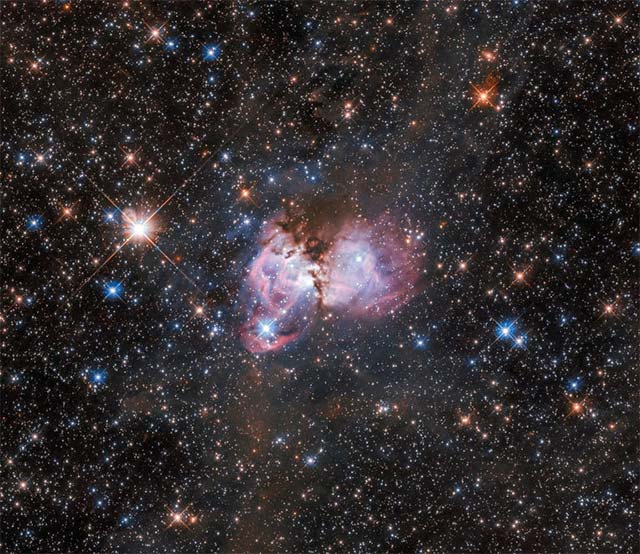Admire the giant stars forming in the corner of the Tarantula Nebula
The universe is constantly moving, bringing new and wonderful things that people have never known. Recently, the Hubble Space Telescope captured a stunning, unique image of a massive star-forming region called LHA 120-N 150, located on the 'outskirts' of the Tarantula Nebula .
The Tarantula Nebula, located more than 160,000 light-years from Earth in the Large Magellanic Cloud, is a small dwarf galaxy that acts as a satellite to our Milky Way Galaxy. According to astronomers, this is considered the largest 'star nursery' in the universe that mankind has known. In other words, the Tarantula Nebula contains an extremely active region of cosmic gas and dust, combined with the gravity that forms new stars.

Astronomers have spent years studying LHA 120-N 150 to better understand the environment of the formation of big stars, and this time they found something special. In theory, big stars are usually born in star clusters, with only 10% forming in isolation. The huge Tarantula Nebula with its extremely diverse structure can be considered a perfect laboratory for solving unresolved questions regarding the birth of giant stars.
However, research on big stars is a challenge in astronomy. Simply because when stars are in the process of forming, they look very much like a dense cloud of dust. One way to study dust areas is to use telescopes that operate on different wavelengths in addition to visible light. Such as. NASA's Spitzer Space Telescope has been observing targets for years through infrared, giving fairly good results. This allows scientists to 'see through' dust clouds and observe the underlying structures to better understand the birth of a giant star.
You should read it
- Hubble Telescope extremely rare photo of the moment of the Supernova explosion
- The interaction between the Milky Way and a satellite galaxy is creating many new stars
- Unique giant eye named Helix in space
- Which star lives the longest, brightest, biggest, ... in the universe?
- How big can the stars in the universe be?
- This star 'tears up' its companion to create a rare beautiful nebula
- Admire the moment millions of new stars are born in the Lupus 3 nebula
- The star is 25 times larger than the Sun, suddenly disappearing, causing astronomers to be confused
- The star about to explode is 100,000 times brighter than the Sun, the light emitted can be observed from the Earth
- Lonely star glitters in the background of an amorphous galaxy in the eyes of the Hubble telescope
- The Most Powerful Space Telescope Ever Built Will Look Back In Time To The Dark Ages Of The Universe
- Detecting UGC 2885, a giant spiral galaxy, 2.5 times larger than the Milky Way galaxy
May be interested

Journey of humans overcome dangerous diseases in history

Close-up of how the medical mask production line operates?

Decipher the mystery of the origin of billions of tons of ice that exists on Mercury

Why do adult bodies have 206 bones but babies have 300?

Why do dead cockroaches often back up to the sky

How to nap scientifically for a healthy and alert body






 The Tarantula Nebula appears beautifully through the eyes of the Hubble telescope
The Tarantula Nebula appears beautifully through the eyes of the Hubble telescope This star 'tears up' its companion to create a rare beautiful nebula
This star 'tears up' its companion to create a rare beautiful nebula Admire the moment millions of new stars are born in the Lupus 3 nebula
Admire the moment millions of new stars are born in the Lupus 3 nebula The Hubble Telescope finds a galaxy glowing strangely from behind a dark nebula
The Hubble Telescope finds a galaxy glowing strangely from behind a dark nebula Admire incredibly detailed images of the Orion Nebula through the eyes of the James Webb telescope
Admire incredibly detailed images of the Orion Nebula through the eyes of the James Webb telescope Unique giant eye named Helix in space
Unique giant eye named Helix in space